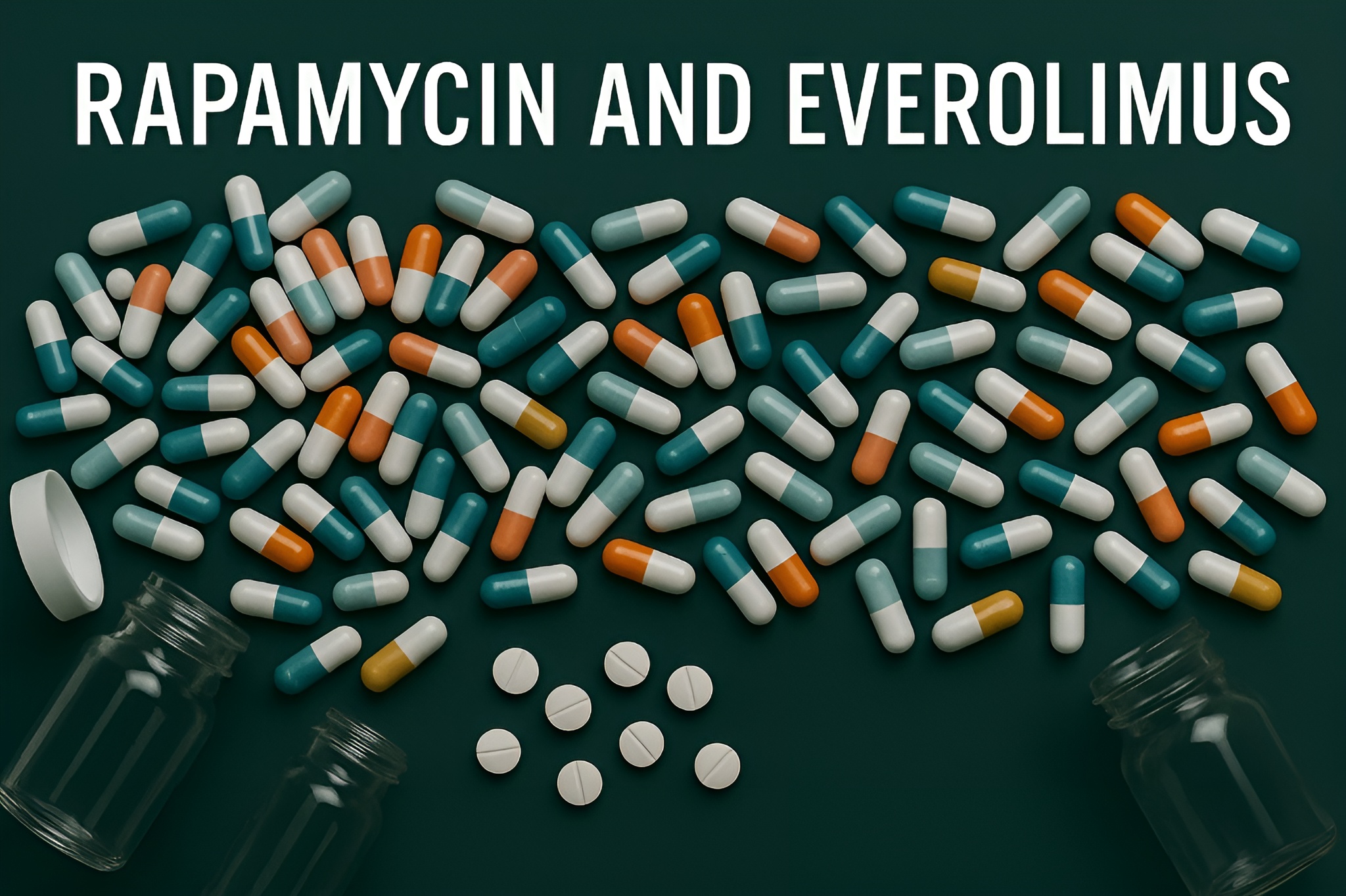Although life expectancy is increasing, healthy life expectancy is not increasing at the same pace. This means people spend more years being sick or having poor health problems. Therefore, the disease burden is shifting to chronic disease that prompting a paradigm shift in aging research and two pharmaceutical compounds may be at the center of this revolution. Rapamycin and Everolimus: The Most powerful Anti‑Aging Drugs For Human Longevity are no longer just a bold headline. Initially used for transplants and cancer, now they captured the attention of longevity scientists, biohackers and clinicians alike. They are now being reexamined as potential geroprotective therapies—drugs that could delay or even reverse aspects of aging. In this article, we’ll define what Rapamycin and Everolimus are, how they work, what the science says, their benefits and risks and why they’re being studied as potential life-extending and healthspan-enhancing therapies.
What Is Rapamycin?
Rapamycin (also known as Sirolimus) is a compound originally discovered in the soil of Easter Island (also known as Rapa Nui, hence the name). It was first developed as an antifungal agent but later found to have powerful immunosuppressive and anti-proliferative properties. Rapamycin was approved by the FDA in 1999 to prevent organ rejection in kidney transplant patients. Since then, research has uncovered its potential beyond immunosuppression — particularly in the areas of aging, cancer, and metabolic health.
What Is Everolimus?
Everolimus is a derivative of Rapamycin with similar biological activity but better pharmacokinetics (e.g. absorption and stability in the body). It is FDA-approved under brand names like Afinitor and Zortress for various uses including cancer treatment and transplant rejection prevention. Everolimus is part of a class of drugs known as mTOR inhibitors, which regulate cell growth, metabolism, and survival.
How Do Rapamycin and Everolimus Work?
Rapamycin and Everolimus inhibit mTOR, a key protein kinase involved in regulating cell growth, metabolism, and survival. mTOR exists in two complexes: mTORC1 and mTORC2, each with distinct functions in the cell. Rapamycin directly targets mTORC1, which regulates protein synthesis, nutrient sensing, and cellular metabolism. mTORC2 is less affected by short-term Rapamycin use and plays a different role in cell signaling. Inhibiting mTORC1 mimics caloric restriction, a well-known method for extending lifespan in various species. This inhibition activates autophagy, the body’s natural process for recycling damaged or unneeded cellular components. It also reduces chronic inflammation and enhances resistance to stress at the cellular level. These effects contribute to healthier aging and are associated with increased longevity in many organisms. mTOR inhibition slows age-related tissue damage and supports improved metabolic flexibility in the body. This flexibility helps the body efficiently switch between different energy sources as needed.
Rapamycin and Longevity: What Does the Science Say?
Scientific research on Rapamycin and longevity has shown promising results, especially in animal models. Studies in mice show Rapamycin can extend lifespan by up to 100% (up to 440% in lame mice), even with effect when started in middle age. Similar responses are seen in yeast, worms, flies, and mice, suggesting a shared biological mechanism across species. In dogs, early studies suggest Rapamycin improves heart health and immune function, supporting its role in healthy aging. No long-term human trials have confirmed lifespan extension, but small studies show improved immune responses in older adults. Biohackers are experimenting with low-dose Rapamycin as an anti-aging tool, though strong human evidence is still lacking.
Key Benefits of Rapamycin and Everolimus
Rapamycin and Everolimus are under extensive research for potential health benefits. A major focus is their impact on longevity and extending healthspan through cellular maintenance and repair. These compounds promote autophagy and rejuvenation, possibly delaying age-related diseases like cancer and neurodegeneration. In cancer treatment, Rapamycin inhibits tumor growth and is approved for several cancers, including kidney and breast cancers. It’s also used for neuroendocrine tumors, showing effectiveness in slowing cancer cell progression. Another key area is immune modulation, especially in older adults using low doses. Although traditionally immunosuppressive, low-dose Rapamycin may enhance immune function and increase resistance to infections in the elderly. Cognitive protection is also being investigated in animals, showing reduced signs of aging and Alzheimer’s-like symptoms. Rapamycin may also improve metabolism by enhancing insulin sensitivity and reducing fat, depending on dose and treatment duration.
Risks and Side Effects
While Rapamycin and Everolimus show great promise for promoting longevity and improving healthspan, they are not without risks—particularly when used long-term or at high doses. Some of the most commonly reported side effects include mouth ulcers, elevated blood lipid levels, insulin resistance in certain individuals, delayed wound healing, and suppressed immune function, especially at higher dosages. These potential adverse effects highlight the importance of careful dosing and medical supervision. Notably, most anti-aging plans suggest taking Rapamycin in small doses and not every day. This approach seems to lower the chance of side effects while still giving many of the helpful health benefits.
Differences Between Rapamycin and Everolimus at a Glance
| Category | Rapamycin (Sirolimus) | Everolimus |
| Origin & Development | Naturally derived from Streptomyces hygroscopicus found on Easter Island (Rapa Nui) | Semi-synthetic derivative of rapamycin, designed to improve drug performance |
| Chemical Structure | Unmodified macrocyclic lactone | Contains a 2-hydroxyethyl group to enhance solubility and absorption |
| Pharmacokinetics | Longer half-life (~60 hours); slower absorption and lower oral bioavailability | Shorter half-life (~30 hours); higher oral bioavailability for more consistent dosing |
| Mechanism of Action | Inhibits mTORC1 (and possibly mTORC2 at high doses); promotes autophagy, slows cell growth | Selectively inhibits mTORC1; may have reduced impact on mTORC2, potentially fewer side effects |
| FDA-Approved Uses | Organ transplant rejection- Lymphangioleiomyomatosis (LAM) | Kidney, breast, and pancreatic cancers- Tuberous sclerosis complex- Transplant rejection |
| Tissue Penetration | Moderate; less targeted for tumor tissue | Enhanced tissue penetration; more effective in solid tumor environments |
| Clinical Flexibility | Primarily used in immunosuppression and niche lung disease | Broader oncology and transplant applications; often used in combination therapies |
| Use in Longevity Research | Widely studied in animal models; shown to increase lifespan and delay age-related decline | Studied in humans for immune rejuvenation; early trials show improved vaccine response |
| Dosing Considerations | Less predictable blood levels; longer washout period | More stable pharmacokinetics; preferred in settings requiring tight dosing control |
Conclusion
Rapamycin and Everolimus are no longer only for transplant patients — they now stand at the forefront of the longevity revolution. Backed by decades of scientific exploration, these compounds are increasingly viewed as the most powerful anti-aging drugs for human longevity. Rapamycin and Everolimus are emerging not just as medical treatments, but as game-changers in the quest for a longer, healthier life and preventive medicine. With thoughtful dosing, medical oversight, and ongoing research, these mTOR inhibitors may redefine what’s possible in preventive medicine and healthy aging. The future of longevity may not be about adding years at the end—but adding vitality and resilience to every year of life.


